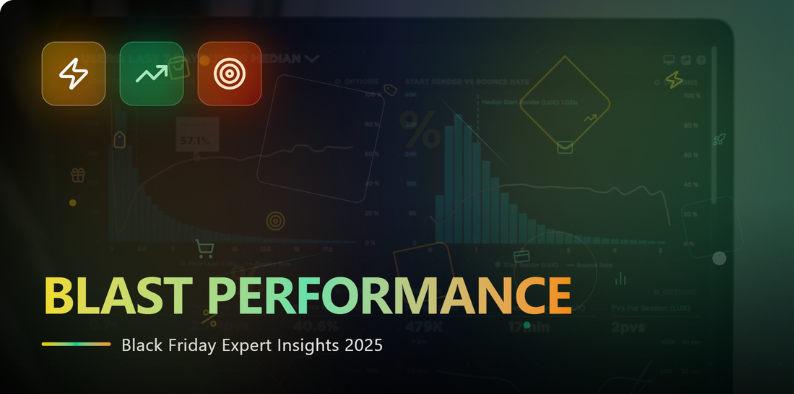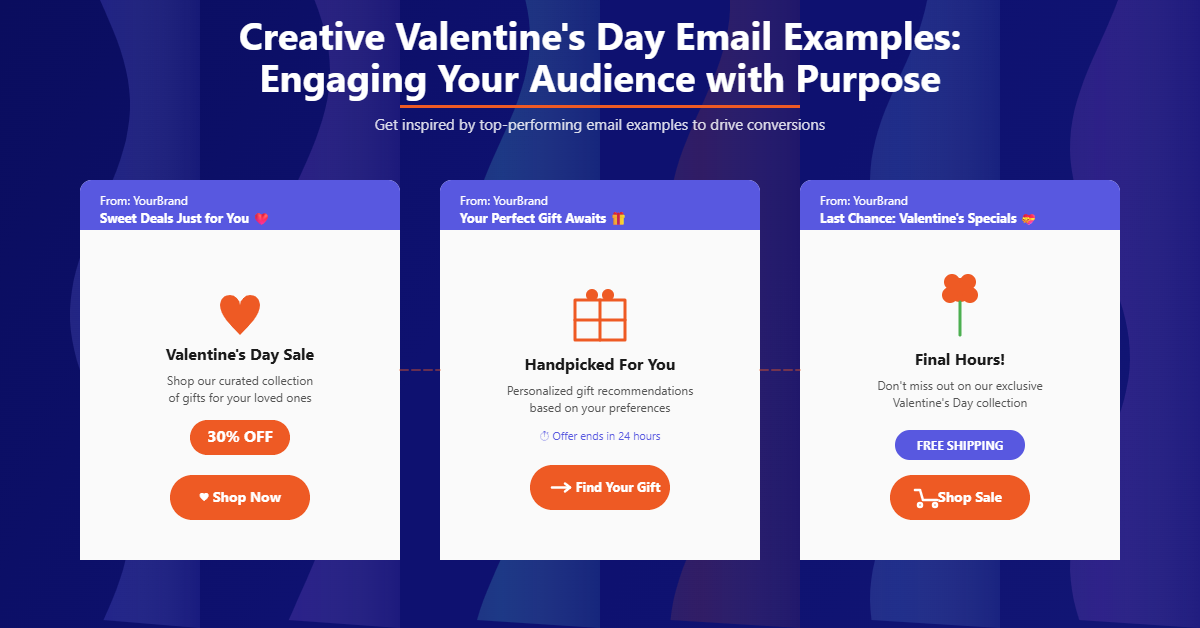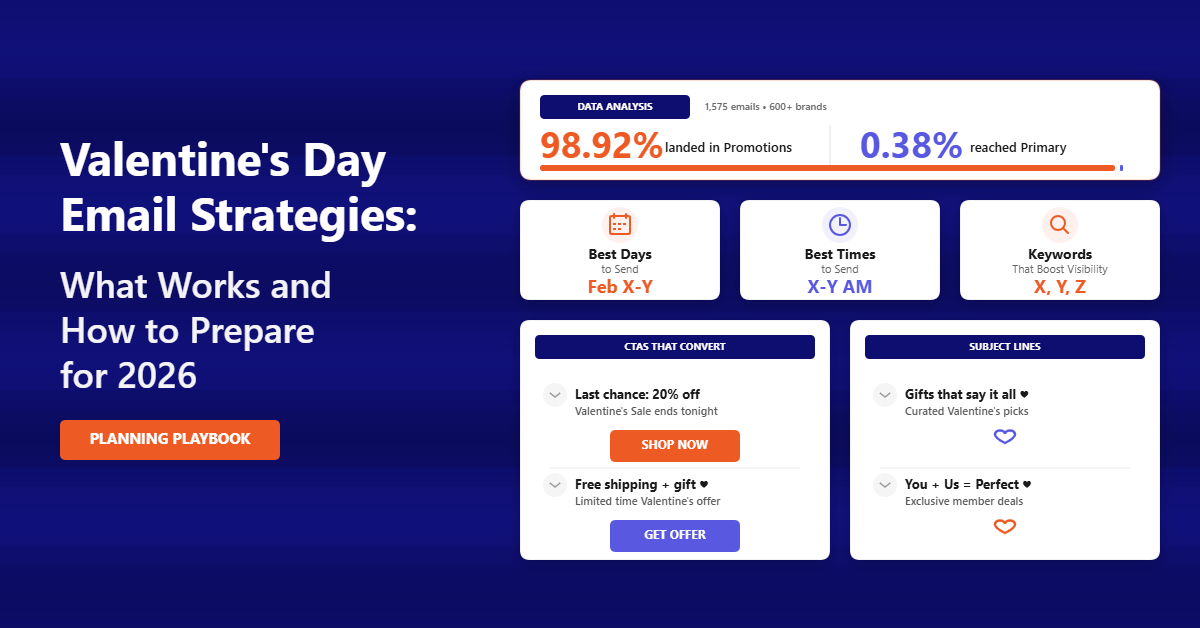Quick Summary
We analyzed 5,025 Black Friday-related emails from 1,404 brands over 399 days.
Frequent blasting correlates with lower inbox placement and higher spam.
Monday sees elevated spam rates even though it’s a top sending day.
Keep subject lines around 8–9 words and 45 characters, pair with a preview of around 18–20 words, and use short CTAs.
Friday dominates sending volume and inbox success, with the highest inbox placement clustering between 1 PM and 3 PM and a peak at 1 PM.
Stagger send frequency to avoid fatigue for your core Black Friday Email Blast.
It’s 12:57 PM on a Friday in November. Your team is queued up to push the big Black Friday Email Blast.
You know everyone else is sending too, but you also know something they don’t. We found a specific window where inbox placement climbs, spam risk dips, and clicks follow.
That time is what this guide is built around. It’s a pattern that emerges when you zoom out across brands, campaigns, and send behaviors.
And yes, it changes when you send too frequently, stack your blasts on the wrong day, or repeat the same “Shop now” CTA without context. Let’s unpack the numbers and give you an easy, reliable playbook for 2025.
What our 399-day study covered
Our dataset includes 5,025 emails from 1,404 eCommerce brands sent across a 399-day period.

The analysis spans inbox placement, spam behavior, send frequency, day-of-week trends, and content traits like subject length and CTA choices. Not every message went to the inbox or spam; a significant portion likely landed in the Promotions tab, which is important context when you interpret the best day and time to send.
This isn’t a theoretical recommendation. It’s a composite of how brands actually sent and how those emails performed in real inboxes, including how often high-frequency senders were filtered to spam.
The Best Time To Send Black Friday Email Blast: Day and hour
When we isolate emails that landed in the inbox, Friday emerges as the anchor day. Of the messages that reached the inbox, Friday was the most common sending day, accounting for 1,276 emails.
Within that, the 1 PM to 3 PM block stood out, with 201 emails sent in that window and a notable peak at 1 PM.
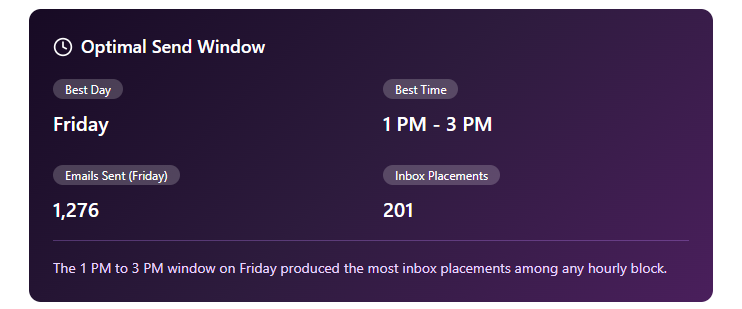
Inbox placement by hour reinforces this pattern. The highest inbox placement occurred at 1 PM with a 14.29% rate, followed by 5 PM at 9.09%.
While 5 PM looks good at first glance, it overlaps with one of the most common spam hours, which muddies the result. The 1 PM slot, in contrast, balances visibility with lower inbox risk.
In practical terms, the Best Time To Send Black Friday Email is Friday between 1 PM and 3 PM, with 1 PM as the sweet spot. If your audience is spread across time zones, schedule by recipient local time to maintain that advantage consistently.
Why Friday wins and Monday misfires
Friday is the busiest day for sending, representing 25.29% of all Black Friday blasts. Monday follows at 14.95%, with Thursday at 13.69%.
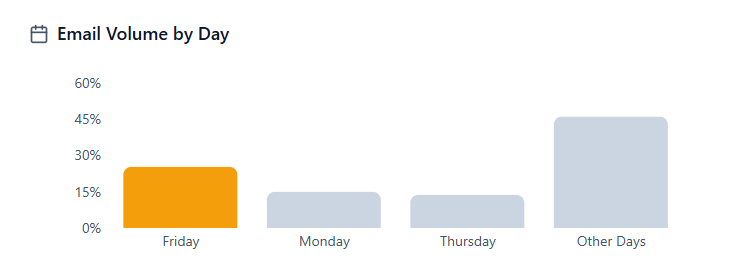
High sending volume doesn’t automatically mean lower performance, though. Our data shows Friday’s spam rate is significantly lower than Monday’s during peak activity. On Monday, 12.25% of emails landed in spam versus only 4.31% on Friday.
There are two likely reasons. First, mailbox providers appear to tolerate elevated promotional volume on Fridays without penalizing as harshly, particularly early afternoon when engagement is strong.
Second, Monday accumulates the aftershock of high-volume weekend mail, so repeated or overly promotional content may trigger filters more aggressively.
This doesn’t mean you should never email on Monday. It does mean Monday needs a different strategy; more segmentation, more personalization, and lighter frequency leading in.
If you must send on Monday, avoid the 4 PM to 5 PM window where spam placement spikes at 12.30% and 11.48% respectively.
Frequency, fatigue, and inbox health
Frequency is the lever that can quietly upend even the perfect timing.
High-frequency senders in our dataset showed an inbox placement rate of just 1.32% and a spam rate of 3.40%. That’s a clear warning sign that hammering your list with blast after blast erodes sender reputation quickly.
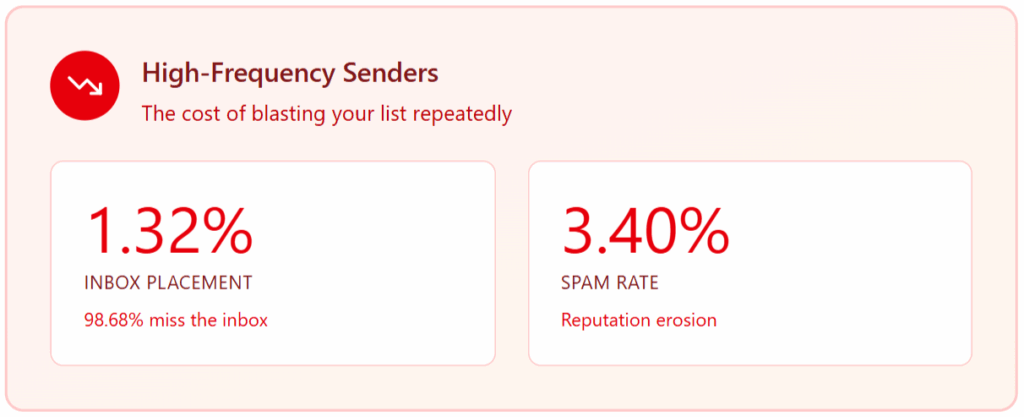
Across the broader sample, brands sent on average 1.90 Black Friday-related emails per week in 2024 and 2.18 emails per week in 2025 during the holiday periods studied.
The upward trend suggests the market is getting noisier. If you’re ramping frequency, you need an offsetting tactic such as tighter segmentation, better audience pruning, or send-time optimization by segment.
The top five brands by campaign count averaged only 2 days and 14 hours between blasts. If you adopt a similar cadence, consider versioning your content so you don’t repeat the same hooks and offers, and ensure your later sends suppress recent engagers who haven’t clicked.
The brands sending the most Black Friday campaigns
A handful of brands set the pace for volume. Slingmods led with 68 campaigns, followed by unknowncomicbooks with 62, Crate and Barrel with 47, The Children’s Place with 45, and The Brick with 38 Black Friday email blast.
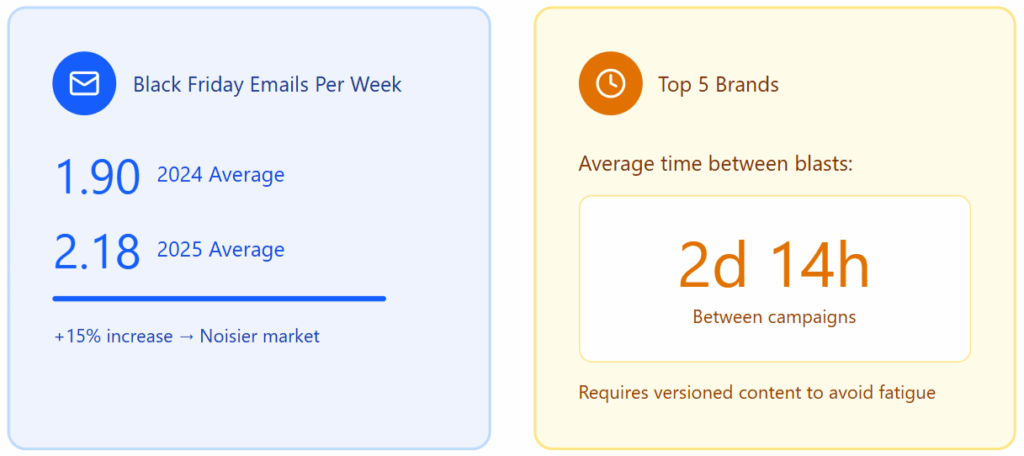
High volume isn’t inherently negative, but it intensifies the need for precise timing and strict audience controls. If your Black Friday Email Blast plan mirrors these counts, the 1 PM Friday slot can be your anchor, with midweek grooming sends to keep your file warm without tripping filters.
One practical technique is to segment your heavy buyers for earlier-week updates and reserve your broadest, boldest send for Friday, early afternoon.
This approach respects mailbox sensitivity while maximizing the moment when shoppers are most primed to act.
Writing high-performance Black Friday Email Blast content
Timing opens the door, but content determines whether you walk through it.
In campaigns we analyzed, Black Friday email subject lines averaged 8.3 words and 45 characters, previews averaged 18.5 words and 80.6 characters, and CTAs hovered around 1.92 words.
That compact trio is ideal for mobile screens and quick scanning during a crowded period. Stay concise with your subject while communicating a concrete hook.
A 45-character subject can comfortably hold an offer and urgency cue without truncation. Pair it with an 18–20 word preview that adds context or credibility to reduce ambiguity and increase open intent.
Keep your CTA tight and focused, preferably two words, and avoid overusing “Shop now” in sequence because filters and customers both tune it out.
“Shop now” appeared 357 times in our sample, with “Shop” used 71 times and “Shop Sale” 42 times.
You don’t need to abandon these evergreen CTAs, but rotate in alternatives aligned to your offer, like “Unlock deal,” “See picks,” or “Claim 20%.” Small shifts help your content look less templated and reduce repetition signals.
Timing and tab placement: Inbox versus spam and Promotions
Not every message lands in either the inbox or the spam.
Many legitimate Black Friday messages go to the Promotions tab, which remains a productive placement for eCommerce when expectations are set. The distinction matters because the Best Time To Send Black Friday Email should be tuned for Inbox potential without neglecting Promotional context.

Our hourly view makes this practical. The 1 PM hour correlates with the highest inbox placement and strong user availability.
Meanwhile, the 4 PM and 5 PM slots show elevated spam placement, which can result from aggressive throttling by mailbox providers when late-afternoon promotional floodgates open.
If your primary goal is engagement volume over strict inbox placement, a late afternoon send can still work, but it requires more segmentation and stronger reputation signals to stay clear of filters.
Campaign cadence and creative consistency
The best-performing cadence we observed combines a controlled ramp with a Friday thrust.
Use early-week messages for waitlist confirmations, early access notices, and transparency around shipping windows. Save your most compelling sitewide offer or doorbuster selection for Friday, early afternoon.
If you’re planning multiple Black Friday Email Blast sends on Friday itself, space them at least several hours apart to avoid hitting the same recipients twice in a high-risk window.
Consider how content consistency plays into filtering. Repeating the same subject formats, preview language, and CTA text across several sends in a short period can trigger pattern-based filtering.
Build a creative matrix with rotating elements, offer framing, social proof, and urgency language that still feels branded but avoids cookie-cutter duplication.
Scheduling Playbook for 2025
If you need a clear path to act on the data, anchor your main Black Friday Email Blast on Friday between 1 PM and 3 PM local time, aiming for 1 PM where possible.
Use Thursday for VIP early access with a lighter segment and a slightly different subject structure to avoid repetition.
If you send on Monday, increase personalization, soften your frequency, and avoid the late-afternoon window where spam placement spikes.
Send frequency in 2025 is trending higher than 2024. To protect your reputation, cap your total number of blasts with built-in suppressions for non-openers beyond two consecutive sends.
Balance the pressure of “now or never” with smart dampening so your best messages have room to breathe. The goal is to hit the Best Time To Send Black Friday Email with your highest-quality audience rather than everyone at once.
Finally, pay attention to your creative mechanics. Keep your Black Friday email subject lines around 8–9 words and 45 characters, avoid repeating the same three CTAs, and aim for a preview line that adds context rather than duplicating the subject.
These small choices compound when volume increases and filters become more sensitive.
A note on high-volume senders and what to learn
The top five volume brands averaged a 2-day-and-14-hour gap between blasts during the period studied.
It’s possible to send frequently and win, but you’ll need three disciplines. First, lock your primary send to Friday early afternoon.
Second, segment tightly so each subsequent message goes to a different intent tier.
Third, diversify your creative structure so no two blasts look algorithmically identical.
The rewards of this approach are tangible. Friday’s lower spam rate compared to Monday, combined with the 1 PM inbox placement peak, gives your most important message both visibility and deliverability. The rest of your week should support that send rather than compete with it.
Putting it all together with the right tooling
Timing and frequency control are easier when your marketing stack can schedule by local time zones, throttle sends by hour, and dynamically segment high-intent and at-risk subscribers.
TargetBay Email & SMS can help operationalize this, from setting a Friday 1 PM send across time zones to using its AI agent to shape subject lines around optimal length and clarity.
Pairing campaigns with TargetBay Reviews content inside the email can lift trust in crowded inboxes, and a targeted bonus via TargetBay Rewards can nudge fence-sitters without over-relying on blanket discounts.
Conclusion: Your Friday 1 PM advantage
The data points to a clear, defensible answer to the question of the Best Time To Send Black Friday Email.
Friday remains the strongest day by volume and inbox success, with a pronounced performance edge between 1 PM and 3 PM and a peak at 1 PM. Monday is still busy but riskier, with materially higher spam placement. High-frequency blasting correlates with poor inbox outcomes, making controlled cadence and creative variation essential.
Keep your subject concise, your preview purposeful, and your CTAs tight, and reserve your broadest reach for that prime Friday window.
If your brand wants a predictable rhythm for 2025, let your core Black Friday Email Blast own Friday early afternoon, support it with segmented updates earlier in the week, and manage fatigue with thoughtful suppressions. A unified platform like TargetBay helps you execute this plan consistently, timing, segmentation, reviews, and loyalty incentives working together, so your best message arrives when customers are most ready to act.



